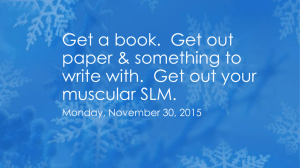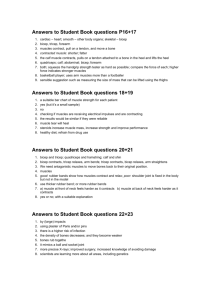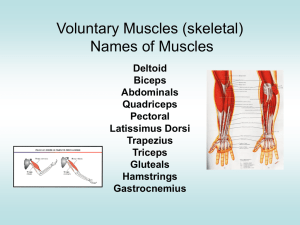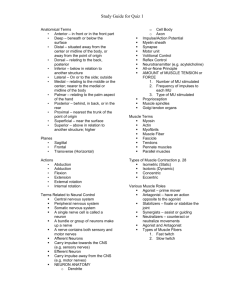Muscle Movement Terminology
advertisement
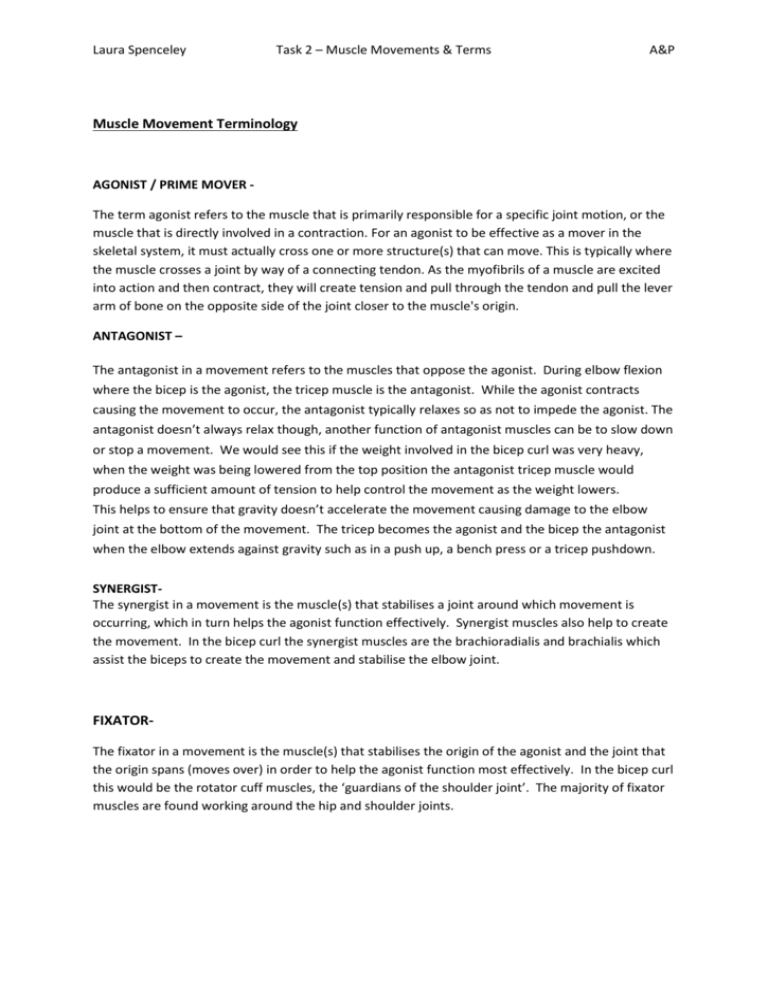
Laura Spenceley Task 2 – Muscle Movements & Terms A&P Muscle Movement Terminology AGONIST / PRIME MOVER The term agonist refers to the muscle that is primarily responsible for a specific joint motion, or the muscle that is directly involved in a contraction. For an agonist to be effective as a mover in the skeletal system, it must actually cross one or more structure(s) that can move. This is typically where the muscle crosses a joint by way of a connecting tendon. As the myofibrils of a muscle are excited into action and then contract, they will create tension and pull through the tendon and pull the lever arm of bone on the opposite side of the joint closer to the muscle's origin. ANTAGONIST – The antagonist in a movement refers to the muscles that oppose the agonist. During elbow flexion where the bicep is the agonist, the tricep muscle is the antagonist. While the agonist contracts causing the movement to occur, the antagonist typically relaxes so as not to impede the agonist. The antagonist doesn’t always relax though, another function of antagonist muscles can be to slow down or stop a movement. We would see this if the weight involved in the bicep curl was very heavy, when the weight was being lowered from the top position the antagonist tricep muscle would produce a sufficient amount of tension to help control the movement as the weight lowers. This helps to ensure that gravity doesn’t accelerate the movement causing damage to the elbow joint at the bottom of the movement. The tricep becomes the agonist and the bicep the antagonist when the elbow extends against gravity such as in a push up, a bench press or a tricep pushdown. SYNERGISTThe synergist in a movement is the muscle(s) that stabilises a joint around which movement is occurring, which in turn helps the agonist function effectively. Synergist muscles also help to create the movement. In the bicep curl the synergist muscles are the brachioradialis and brachialis which assist the biceps to create the movement and stabilise the elbow joint. FIXATORThe fixator in a movement is the muscle(s) that stabilises the origin of the agonist and the joint that the origin spans (moves over) in order to help the agonist function most effectively. In the bicep curl this would be the rotator cuff muscles, the ‘guardians of the shoulder joint’. The majority of fixator muscles are found working around the hip and shoulder joints. Laura Spenceley Task 2 – Muscle Movements & Terms A&P EXAMPLES IN SPORT - ROWING Rowing is a coordinated muscle action that involves every large muscle group in the body. A basic rowing stroke is split up into four key phases; the catch, the drive, the finish and the recovery. The following sections illustrate the primary muscles used during each movement of the rowing stroke and which muscles are acting as the agonist, antagonist, fixator and synergist. 1. The Catch In this position your legs are compressed and shins vertical. Your triceps contract as the agonist to extend your arm whilst the bicep muscles work as antagonists relaxing to oppose the tricep movement. Your back muscles are relaxed, and your abdominals are flexing your torso forward. 2. The drive You initiate the drive with the powerful muscles of your legs, and all of the shoulder muscles are contracting. As you work through the drive sequence, your biceps engage to pull the handle toward your abdomen, your back muscles work more as you swing your torso open, and your glutes and hamstrings contract to extend the hip. As the drive finishes with the arm pull-through, nearly all the muscles of your upper body engage. 3. The finish At the finish, the abdominals stabilize the body, and the glutes and quads are contracting. The biceps and many of the back muscles are also contracting to help keep the torso in the finish position and to internally rotate the upper arms. 4. The Recovery The triceps engage to push the arms forward and away from the body. The abdominals flex the torso forward, and the hamstrings and calves contract as you slide up to the catch. Laura Spenceley Task 2 – Muscle Movements & Terms A&P
